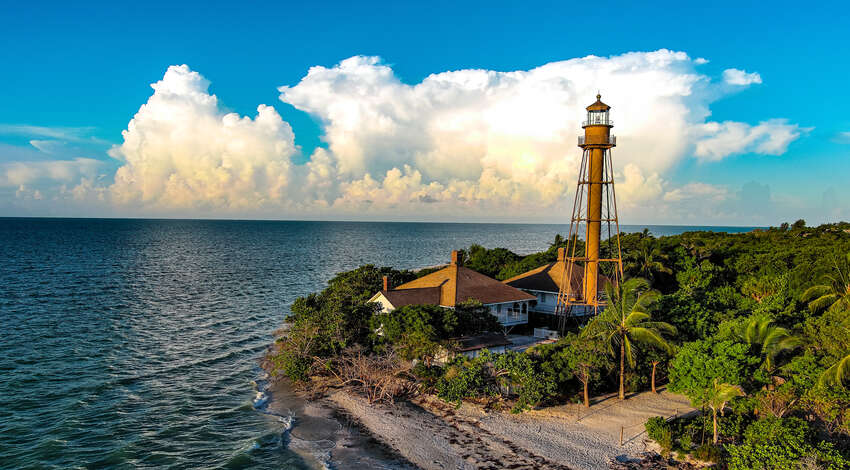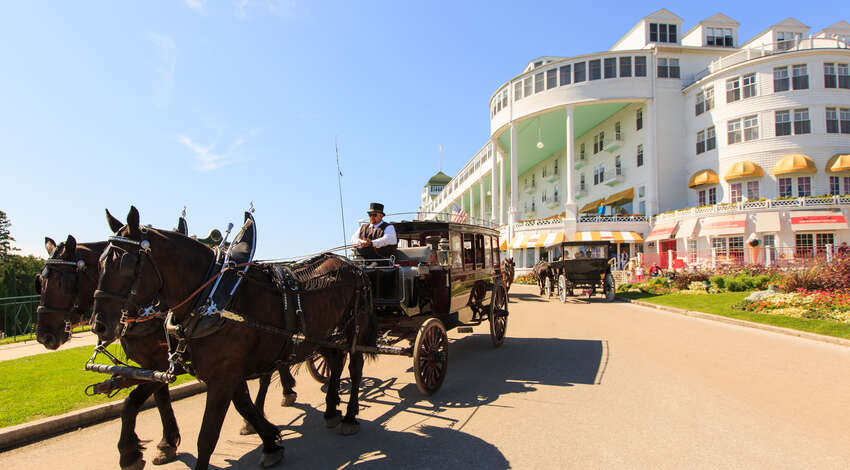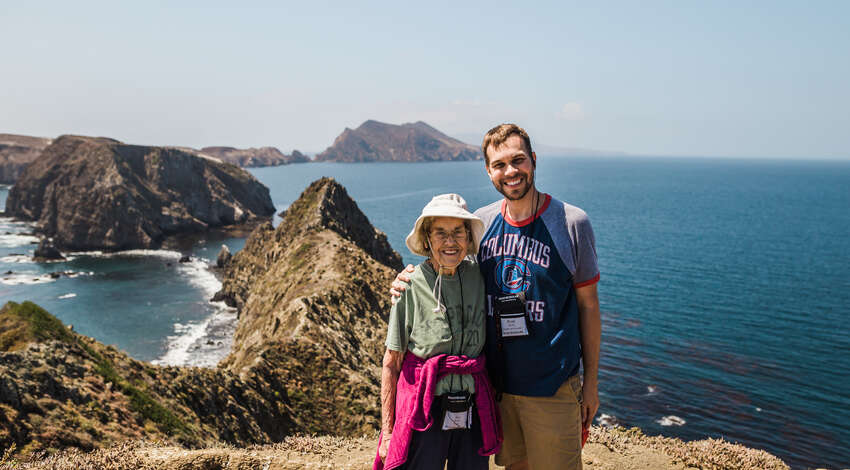Surrounded by Water — and Adventure: Islands We Love for Learning
“Islands are invitations to adventure,” says the writer Addison Wiggin, and we couldn’t agree more. Scores of Road Scholar learning adventures take place on islands. Internationally, they range from Japan to Iceland and from Malta to the Galápagos, but some of the ones nearest and dearest to our hearts take place on islands across the U.S.
Here’s a look at our favorite islands for learning in the contiguous 48 states.

Sanibel Island, Florida
San Juan Islands
Tucked up between the southern tip of Vancouver and the northern coast of Washington state, the San Juans boast spectacular scenery and equally impressive wildlife, particularly the orca whales that inhabit the waters surrounding them and the bald eagles that patrol the skies — the largest concentration of our national bird in the U.S. You can explore the San Juans with us by boat, on foot or, if you’re feeling particularly adventurous, by sea kayak.
Fun fact: The shortest U.S. international flight is from the San Juans to Victoria, B.C. It takes 12 minutes.
Florida Keys
About as far away from the San Juans as it is possible to get in the contiguous 48, the Florida Keys are a place to trade your sea kayak for a snorkel and a few miles seaward, explore the world’s third-largest living coral reef (with a grandchild, if you’re so inclined). There’s plenty to fascinate you on land, as well, in this famously laid-back island chain, from Hemingway’s haunts to Truman’s Little White House to the legacy of Tennessee Williams. We’ll show you all of it!
Fun fact: Key West is the southernmost incorporated place in the 48 contiguous states.
Sanibel
Up Florida’s west coast a bit you’ll find the barrier island of Sanibel, bouncing back with spirit from recent hurricanes. The weather did little to diminish the splendor of the island’s flora and fauna, particularly the dazzling array of birds at the J.N. “Ding” Darling National Wildlife Refuge. Both the refuge and Sanibel’s legendary shelling beaches are among the focal points of our learning journeys to the island, as are the Edison and Ford winter estates in nearby Fort Myers.
Fun fact: Beachcombing for Sanibel’s 400 varieties of shells gave rise to the term “Sanibel Stoop,” the local name for the hunched-over position of shell-seekers.
Chincoteague
Chincoteague Island (and nearby Assateague and Wallops Islands) are best known for the wild horses that roam the beaches and dunes there, whose ancestors very possibly swam ashore from a wrecked Spanish galleon. But the islands hold other attractions as well, including Assateague Island National Seashore, which provides a protected environment for an abundance of shorebirds and other wildlife. Road Scholar offers birding-specific programs to the islands, as well as kayaking adventures and service-learning journeys to help with preservation.
Fun fact: For those who were captivated by the book and movie “Misty of Chincoteague,” about one of the wild horses, we also have family programs on Chincoteague focused on the story.

Mackinac Island, Michigan
Washington Island
Wisconsin’s Door County, jutting out into Lake Michigan, is a scenic wonderland and a treasure trove of maritime history. Off its northern tip sits Washington Island, reachable only by ferry. Among the highlights of the island (a stop on our Door County learning adventure) are the Stavkirke, built in the 1980s and modeled after a 12th-century Norwegian church, and picturesque Schoolhouse Beach, one of only five in the world composed of smooth-worn white limestone rocks.
Fun fact: Another quirky spot on this tiny, 800-resident island is Nelsen’s, a tavern that is the world’s largest purveyor of Angostura bitters, thanks to an “enterprising” Prohibition-era owner.
Mackinac Island
Still farther north in Lake Michigan is Mackinac Island, reachable only by boat or plane — there are no bridges to the mainland. Even if there were, you couldn’t use them — cars are not permitted on the island, and never have been. Instead, the transportation of choice is a horse-drawn carriage (or simply a horse, if you’re a rider) or one’s own feet. Historic forts and exquisite Victorian mansions compete for attention with the panoramic water views. On Road Scholar’s Mackinac program, you’ll explore the history and architecture of the island, go birding in Mackinac’s protected habitats and take tea at the 19th-century Grand Hotel.
Fun fact: Humans aren’t the only seasonal visitors to the island. The 500 or so working horses are brought to the island each spring, and taken off each winter.
Martha’s Vineyard/Nantucket
On Martha’s Vineyard and Nantucket off the coast of Massachusetts, houses help tell some of the most important stories. The stately sea captains’ homes on both islands are reminders of the lucrative whaling industry that flourished in the 18th and 19th centuries. In addition, on Martha’s Vineyard, some 300 charming, restored gingerbread houses line the streets in the town of Oak Bluffs. They were built in the late 1800s as part of the ongoing evolution of a Methodist camp meeting site that had begun with tents in 1835. You’ll be immersed in this history — as well as the islands’ stunning natural beauty — as part of Road Scholar’s program there.
Fun fact: There are no vineyards on Martha’s Vineyard, and there never were. It was named for a vinelike growth found along the coast. (Martha was a sailor’s daughter, by the way.)
Mount Desert Island
Elsewhere in New England, Road Scholar offers learning adventures off the coast of Maine. They take place on Mount Desert Island, home to Acadia National Park — the oldest national park east of the Mississippi and the only one for which the land was donated, not purchased. Highlights of our programs there include walking tours amid the Victorian architecture, explorations of the dramatic southern coast of the island, and hiking on Cadillac and Gorham Mountains, which rewards the hardy with dazzling views in all directions.
Fun fact: From October through March, the top of Cadillac Mountain is the first place to view the sunrise in the U.S.

Participant and her grandson at Channel Islands, California
Manhattan
If you’re looking to get away from it all, this is not the island for you! The heart of New York City, Manhattan is a wonderland for anyone interested in the arts, architecture or U.S. history, and it delivers the most vivid demonstration imaginable of America as a cultural melting pot. You’ll find Road Scholar adventures that showcase all of those things and more, including opportunities to introduce your grandchild or your whole family to the excitement of The Big Apple.
Fun fact: Hot dog vendors in Central Park pay the city more than $200,000 annually to operate a single cart there.
Apostle Islands
In contrast to Manhattan’s 1.6 million residents, the Apostle Islands in Lake Superior are home to about 300. Only one of the islands — Madeline — is inhabited year-round. The rest are designated as a National Lakeshore. The Apostles boast amazing geological features including dramatic sea caves carved out of sandstone. On our educational program, you’ll study the sea caves by boat, learn the history of Indigenous peoples, fur traders and others, and discuss lighthouses and shipwrecks, flora and fauna with local experts.
Fun fact: In winter, the sea caves become even more spectacular, if that’s possible, turning into glittering ice caves that can be visited on foot when conditions permit.
Channel Islands
Another string of nationally protected U.S. islands is set off the coast of Santa Rosa, Calif. The five islands in Channel Islands National Park (of eight total) lie just 60 miles away from a population of over 18,000,000 people, yet they see only about 300,000 visitors each year. The islands have a unique ecosystem, with flora and fauna found nowhere else on earth. Road Scholar programs let you explore them by boat, hike them on foot, and even snorkel the surrounding marine sanctuary.
Fun fact: Among the fauna found only here is the island fox, found on six of the islands with a unique subspecies occupying each.
St. Simons and Jekyll Islands
Georgia’s Golden Isles are rich in both natural and human history. Road Scholar programs explore the islands’ marshlands and ocean beaches, with their tremendous variety of bird species and other wildlife. You can also explore the history of enslaved peoples and plantation life on the islands, contrasted by the mansions of wealthy vacationers of the Gilded Age. Jekyll Island is also home base for many special-interest Road Scholar programs, for bridge players, golfers, watercolorists, silent-film buffs and more.
Fun fact: Over the past 40 years, an artist has carved “tree spirits” into the trunks of about 20 trees scattered around St. Simons, setting up a sort of “Easter egg” hunt for visitors.
That’s a look at a few of the islands we love, and why we love them. If you had your choice (and you do!), which would you pick for your next learning adventure?
